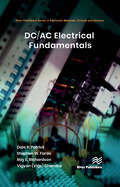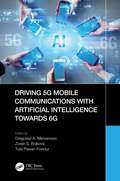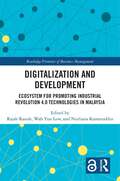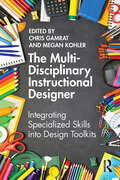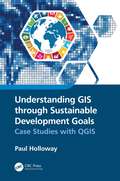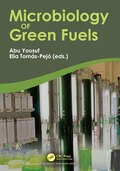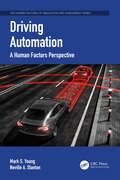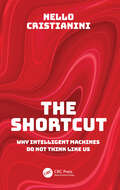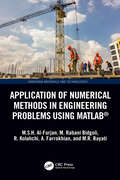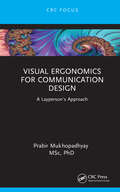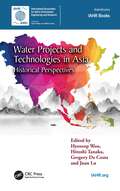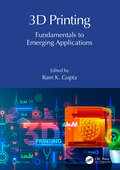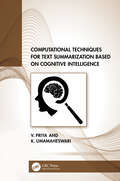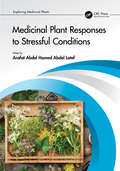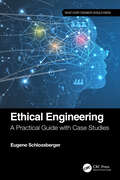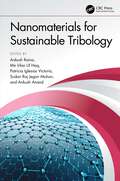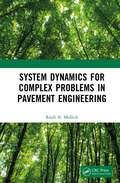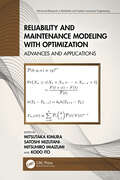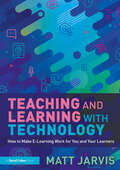- Table View
- List View
DC/AC Electrical Fundamentals
by Stephen W. Fardo Dale R. Patrick Vigyan (Vigs) Chandra Ray RichardsonThis book explores many essential topics in a basic and easy-to-understand manner. This book, and the accompanying Electronic Devices and Circuit Fundamentals, have been modified with significant updates in content. The books are developed using a classic textbook – Electricity and Electronics: A Survey (5th Edition) – as a framework. Both new books have been structured using a similar sequence and organization as previous editions. The previous edition of Electricity and Electronics: A Survey contained 18 chapters, 8 in the Electricity section and 10 in the Electronics section.This book has been expanded to include 19 chapters, further simplifying content, and providing a more comprehensive coverage of the content. The content has been continually updated and revised through new editions and by reviewers over the years. Additional quality checks to ensure technical accuracy, clarity and coverage of content have always been an area of focus.Each edition of the text has been improved through the following features: Improved and updated text content Improved usage of illustrations and photos Use of color to add emphasis and clarify content.
Driving 5G Mobile Communications with Artificial Intelligence towards 6G
by Zoran S. Bojkovic Dragorad A. Milovanovic Tulsi Pawan FowdurDriving 5G Mobile Communications with Artificial Intelligence towards 6G presents current work and directions of continuously innovation and development in multimedia communications with a focus on services and users. The fifth generation of mobile wireless networks achieved the first deployment by 2020, completed the first phase of evolution in 2022, and started transition phase of 5G-Advanced toward the sixth generation. Perhaps one of the most important innovations brought by 5G is the platform-approach to connectivity, i.e., a single standard that can adapt to the heterogeneous connectivity requirements of vastly different use cases. 5G networks contain a list of different requirements, standardized technical specifications and a range of implementation options with spectral efficiency, latency, and reliability as primary performance metrics. Towards 6G, machine learning (ML) and artificial intelligence (AI) methods have recently proposed new approaches to modeling, designing, optimizing and implementing systems. They are now matured technologies that improve many research fields significantly. The area of wireless multimedia communications has developed immensely, generating a large number of concepts, ideas, technical specifications, mobile standards, patents, and articles. Identifying the basic ideas and their complex interconnections becomes increasingly important. The book is divided into three major parts, with each part containing four or five chapters: Advanced 5G communication Machine learning-based communication and network automation Artificial Intelligence towards 6G The first part discusses three main scenarios and standard specification of 5G use cases (eMBB, URLLC, mMTC), vehicular systems beyond 5G, and efficient edge architecture on NFV infrastructure. In the second part, different AI/ML-based methodologies and open research challenges are presented in introducing 5G-AIoT artificial intelligence of things, scheduling in 5G/6G communication systems, application of DL techniques to modulation, detection, and channel coding as well as 5G Open Source tools for experimentations and testing. The third part paved the way to deployment scenarios for different innovative services including technologies and applications of 5G/6G intelligent connectivity, AI-assisted eXtended Reality, integrated 5G-IoT architecture in next-generation Smart Grid, privacy requirements in a hyper-connected world, and evaluation of representative 6G use cases and technology trends. The book is written by field experts from Europe and Mauritius who introduce a blend of scuentific and engineering concepts covering this emerging wireless communication era. It is a very good reference book for telecom professionals, engineers, and practitioner in various 5G vertical domains and, finally, a basis for student courses in 5G/6G wireless systems.
Digitalization and Development: Ecosystem for Promoting Industrial Revolution 4.0 Technologies in Malaysia (Routledge Frontiers of Business Management)
by Rajah Rasiah Nurliana Kamaruddin Wah Yun LowThis book examines the diffusion of digitalization and Industry 4.0 technologies in Malaysia by focusing on the ecosystem critical for its expansion. The chapters examine the digital proliferation in major sectors of agriculture, manufacturing, e-commerce and services, as well as the intermediary organizations essential for the orderly performance of socioeconomic agents. The book incisively reviews policy instruments critical for the effective and orderly development of the embedding organizations, and the regulatory framework needed to quicken the appropriation of socioeconomic synergies from digitalization and Industry 4.0 technologies. It highlights the importance of collaboration between government, academic and industry partners, as well as makes key recommendations on how to encourage adoption of IR4.0 technologies in the short- and long-term. This book bridges the concepts and applications of digitalization and Industry 4.0 and will be a must-read for policy makers seeking to quicken the adoption of its technologies.
The Multi-Disciplinary Instructional Designer: Integrating Specialized Skills into Design Toolkits
by Chris Gamrat Megan KohlerThe Multi-Disciplinary Instructional Designer explores how the instructional design and development process can be energized and deepened through principles gleaned from other fields of academic study. Despite their shared academic preparation and theoretical foundations, many instructional designers come to the profession also bearing formative knowledge from a diverse range of other subject areas, career tracks, creative practices, or intellectual pursuits. Their training, however, typically does not prepare them to leverage these specializations into the creation of more effective educational experiences and materials. This first-of-its-kind book guides instructional designers to apply key concepts, strategies, and lessons learned from a variety of disciplines – spanning the social sciences, arts and humanities, and STEM – to their practice. Chapters replete with example scenarios, reflection activities, and field-tested strategies provide an expansive yet actionable reframing of the profession’s potential. By seeking inspiration across disciplines and from the world at large, instructional designers will emerge with robust and revitalized toolkits, ready to enrich their approach to teaching and learning.
The Multi-Disciplinary Instructional Designer: Integrating Specialized Skills into Design Toolkits
by Chris Gamrat Megan KohlerThe Multi-Disciplinary Instructional Designer explores how the instructional design and development process can be energized and deepened through principles gleaned from other fields of academic study. Despite their shared academic preparation and theoretical foundations, many instructional designers come to the profession also bearing formative knowledge from a diverse range of other subject areas, career tracks, creative practices, or intellectual pursuits. Their training, however, typically does not prepare them to leverage these specializations into the creation of more effective educational experiences and materials. This first-of-its-kind book guides instructional designers to apply key concepts, strategies, and lessons learned from a variety of disciplines – spanning the social sciences, arts and humanities, and STEM – to their practice. Chapters replete with example scenarios, reflection activities, and field-tested strategies provide an expansive yet actionable reframing of the profession’s potential. By seeking inspiration across disciplines and from the world at large, instructional designers will emerge with robust and revitalized toolkits, ready to enrich their approach to teaching and learning.
Understanding GIS through Sustainable Development Goals: Case Studies with QGIS
by Paul HollowayUnderstanding GIS through Sustainable Development Goals applies a pedagogical shift to learning GIS, as the readers employ the concepts and methodologies on real-world problems. This book provides 16 case studies across most of the Sustainable Development Goals (SDGs) with step-by-step practical instructions using QGIS(Quantum Geographic Information System) , an open-source software. It helps readers develop GIS skills on real-world data, while learning the fundamentals including spatial data models, projections, and spatial databases, different cartographic methods, such as graduated symbology, change maps, and dynamic visualization, as well as more intermediate and advanced spatial analysis such as geoprocessing, multiple criteria analysis, and spatial statistics. The topics chosen are taught in secondary and tertiary education institutions which make this a textbook for all students and educators. Features: Focuses on learning GIS through 16 real world case studies. Introduces an open-source software that can be used beyond the classroom. Analyzes Sustainable Development Goals in a global framework and provides an alternative approach to learning GIS. Supports both secondary and tertiary educators and improves GIS education at all levels. Contains a holistic range of case studies that extend across several disciplines, from geography education, environmental sciences, geosciences, natural sciences, social sciences, and digital humanities. This is a textbook for all students and educators, providing 16 case studies across most of the SDGs with step-by-step practical instructions using QGIS, an open-source software.
Microbiology of Green Fuels
by Abu Yousuf Elia Tomás-PejóThe replacement of fossil-derived compounds by bio-based fuels and chemicals is crucial for the implementation of a sustainable bioeconomy. In this context, microorganisms are key players for biofuels’ production from renewable sources. Biotechnological biofuel production processes require conversion microorganisms capable of both efficiently assimilating renewable low-cost carbon sources and diverting their metabolisms towards the specific biofuel. Exploring the wide diversity of microorganisms available on Earth will surely aid to make the production of green fuels a reality. This book gives a wide overview of different microbial-based processes for green fuels production. The book also includes techno-economic analysis and highlights strategic, commercial and environmental interests in promoting green fuels. All these facts make this book very valuable not only for the scientific community but also for biofuel companies and policy makers.
Driving Automation: A Human Factors Perspective (The Human Factors, Simulation and Performance Assessment Series)
by Mark S. Young Neville A. StantonThe technology behind self-driving cars is being heavily promulgated as the solution to a variety of transport problems including safety, congestion, and impact on the environment. This text examines the key role that human factors plays in driving forward future vehicle automation in a way that realizes the benefits while avoiding the pitfalls. Driving Automation: A Human Factors Perspective addresses a range of issues related to vehicle automation beyond the 'can we' to 'how should we'. It covers important topics including mental workload and malleable attentional resources theory, effects of automation on driver performance, in-vehicle interface design, driver monitoring, eco-driving, responses to automation failure, and human-centred automation. The text will be useful for graduate students and professionals in diverse areas such as ergonomics/human factors, automobile engineering, industrial engineering, mechanical engineering, and health and safety.
The Shortcut: Why Intelligent Machines Do Not Think Like Us
by Nello CristianiniAn influential scientist in the field of artificial intelligence (AI) explains its fundamental concepts and how it is changing culture and society.A particular form of AI is now embedded in our tech, our infrastructure, and our lives. How did it get there? Where and why should we be concerned? And what should we do now? The Shortcut: Why Intelligent Machines Do Not Think Like Us provides an accessible yet probing exposure of AI in its prevalent form today, proposing a new narrative to connect and make sense of events that have happened in the recent tumultuous past, and enabling us to think soberly about the road ahead.This book is divided into ten carefully crafted and easily digestible chapters. Each chapter grapples with an important question for AI. Ranging from the scientific concepts that underpin the technology to wider implications for society, it develops a unified description using tools from different disciplines and avoiding unnecessary abstractions or words that end with -ism. The book uses real examples wherever possible, introducing the reader to the people who have created some of these technologies and to ideas shaping modern society that originate from the technical side of AI. It contains important practical advice about how we should approach AI in the future without promoting exaggerated hypes or fears.Entertaining and disturbing but always thoughtful, The Shortcut confronts the hidden logic of AI while preserving a space for human dignity. It is essential reading for anyone with an interest in AI, the history of technology, and the history of ideas. General readers will come away much more informed about how AI really works today and what we should do next.
Application of Numerical Methods in Engineering Problems using MATLAB® (Emerging Materials and Technologies)
by M.S.H. Al-Furjan M. Rabani Bidgoli Reza Kolahchi A. Farrokhian M.R. BayatiApplication of Numerical Methods in Engineering Problems Using MATLAB® presents an analysis of structures using numerical methods and mathematical modeling. This structural analysis also includes beam, plate, and pipe elements, and examines deflection and frequency or buckling loads. The various engineering theories of beams/plates/shells are comprehensively presented, and the relationships between stress and strain, and the governing equations of the structure are extracted. To solve governing equations with numerical methods, there are two general types, including methods based on derivatives or integrals. Derivative-based methods have the advantage of flexibility in modeling boundary conditions, low analysis time, and a very high degree of accuracy. Therefore, the book explains numerical methods based on derivatives, especially the differential quadrature method. Features: Examines the application of numerical methods to obtain the deflection, frequency, and buckling loads. Discusses the application of numerical methods for solving motion equations. Includes numerous practical and applicable examples throughout.
Advanced Power Electronics Converters for Future Renewable Energy Systems
by Rajesh Singh P. Sanjeevikumar Neeraj Priyadarshi Farooque Azam C. BharatirajaThis book narrates an assessment of numerous advanced power converters employed on primitive phase to enhance the efficiency of power translation pertaining to renewable energy systems. It presents the mathematical modelling, analysis, and control of recent power converters topologies, namely, AC/DC, DC/DC, and DC/AC converters. Numerous advanced DC-DC Converters, namely, multi-input DC-DC Converter, Cuk, SEPIC, Zeta and so forth have been assessed mathematically using state space analysis applied with an aim to enhance power efficiency of renewable energy systems. The book: Explains various power electronics converters for different types of renewable energy sources Provides a review of the major power conversion topologies in one book Focuses on experimental analysis rather than simulation work Recommends usage of MATLAB, PSCAD, and PSIM simulation software for detailed analysis Includes DC-DC converters with reasonable peculiar power rating This book is aimed at researchers, graduate students in electric power engineering, power and industrial electronics, and renewable energy.
Corrosion and Protection of Marine Engineering Materials: Applications of Conducting Polymers and Their Composites
by Yanhua LeiThis book provides a basic introduction to the application of conductive polymers in corrosion protection, especially for marine environment corrosion protection research. Conventional anticorrosive coatings, which are based on heavy metals such as chromium, zinc, and copper, are toxic to the environment. There has been a need to find suitable replacement coatings that are environmentally friendly as well as effective in inhibiting the corrosion of steel. Conductive polymers have garnered much attention in recent years due to their environmentally benign nature and high effectiveness in protecting against corrosion. This book introduces the history of these conductive polymers. The applications of conducting polymers, polymer composites, and nanocomposites for corrosion protection of different industrial metal substrates are explored based on reported experimental data, and their mechanism of inhibition is explained. This book also includes overviews of some recent works on marine antifouling, marine heavy-protective coatings, and waterborne paints by conducting polymer and inorganic composites. Conducting polymers and their family of stimuli-actuated polymers exhibit excellent application prospects in the fields of anticorrosion, antibacterial, antibiofouling, and waterborne-based coatings. This book will be of great interest to students, scholars, and professionals alike in the field of corrosion engineering and material science.
Visual Ergonomics for Communication Design: A Layperson's Approach
by Prabir MukhopadhyayVisual Ergonomics for Communication Design reveals the application of ergonomics principles in visual communication design. It enables the visual designer to look at different aspects of visual design from the point of view of the user to ensure that their designs are more user-friendly. The book allows the reader to apply the principles of ergonomics in different facets of communication design such as pictograms, icons and logo design, product labeling, information system in space, and visual ergonomics in simple map design. An introductory chapter allows the reader to learn the basics and principles of visual ergonomics and gives them an insight into the probable application areas. Further chapters delve deeper into the topic with each chapter ending with "Key Points", Practice Sections", and exercises designed to help the reader to revise what they have learned. The reader will benefit from coverage of visual ergonomics in icons, pictograms, and symbols, product labeling, wayfinding in space, and map design which are all backed up with examples and illustrations. Written with the layperson in mind who has no background in the subject, this interesting and easy-to-read reference addresses how to use the different principles of ergonomics in visual communication in a storytelling format. With a narrative structure to the chapters and illustrated throughout, this book is an ideal read for students and professionals looking to strengthen their knowledge of visual communication design by augmenting it with ergonomic principles. It will appeal to students and professionals studying and working in the fields of computer science, human-computer interaction, design engineering, mechanical engineering, information technology, communications engineering, and human factors engineering.
Water Projects and Technologies in Asia: Historical Perspectives (IAHR Books)
by Hitoshi Tanaka Hyoseop Woo Juan Lu Gregory De CostaThis book is a collection of highly refined articles on historical water projects and traditional water technologies of international interest in the Asian region, addressing information on past water projects (mostly before the 20th century) in the Asian regions that are technically and culturally of interest and educationally valuable. This book explores historical water projects in these regions, presenting technologies used at the time, including calculation and forecasting methods, measurement, material, labor, methodologies, and even water culture. It is expected that the old Asian wisdom of "reviewing the old and learning the new" would be realized to a certain extent in modern planning and practice of water projects. This book will enable the reader to understand historical water projects and technologies in the Asian region. It can be used as a one-stop resource to source notable Asian water projects and their relevance to modern-day technology. In this regard, this book is expected to be of interest to a variety of audiences, including the corresponding Asian regions and other international audiences interested in Asian water history from an engineering perspective.
Molecular Mechanisms of Action of Functional Foods and Nutraceuticals for Chronic Diseases: Volume II (Nutraceuticals)
by Yashwant V. Pathak Syam Mohan Shima AbdollahiThere has been a global rise in the incidence of chronic illnesses, which may be partially attributed to the lengthening of the average human lifespan. Functional foods and nutraceuticals have a potential role to play in the development and maintenance of health. They can assist the body in its battle against inflammation and chronic illnesses.Molecular Mechanisms of Action of Functional Foods and Nutraceuticals for Chronic Diseases addresses the effects and mechanism of functional foods in relation to chronic diseases such as obesity, cardiovascular diseases, diabetes, cancer, etc. This volume, like the first volume Applications of Functional Foods and Nutraceuticals for Chronic Diseases, inspires new thought processes and a paradigm shift in research and development.Key Features: Discusses the molecular mechanism of action, the range of toxicities exerted by these food components for functional foods for addressing chronic conditions Enhances scientists and industrial personnel knowledge of functional foods and in the management of chronic diseases Presents research on the role of functional foods/nutraceuticals in preventing and treating chronic diseases through epigenetic modulation Explores various subjects such as epigenetics, immunological, metabolic, technological and neurodenerative aspects affected by functional foods in chronic diseases The world’s leading wellness centers for chronic diseases are using functional foods and nutraceuticals in their practice and discovering their useful applications, and this second of two volume set is another great reference for practitioners, scientists, and clinicians in the management of chronic diseases. Contributors hail from different geographical locations around the world and have many years of research and scholarly experience in functional foods, nutraceuticals, and biology.
3D Printing: Fundamentals to Emerging Applications
by Ram K Gupta3D Printing: Fundamentals to Emerging Applications discusses the fundamentals of 3D-printing technologies and their emerging applications in many important sectors such as energy, biomedicals, and sensors. Top international authors in their fields cover the fundamentals of 3D-printing technologies for batteries, supercapacitors, fuel cells, sensors, and biomedical and other emerging applications. They also address current challenges and possible solutions in 3D-printing technologies for advanced applications. Key features: Addresses the state-of-the-art progress and challenges in 3D-printing technologies Explores the use of various materials in 3D printing for advanced applications Covers fundamentals of the electrochemical behavior of various materials for energy applications Provides new direction and enables understanding of the chemistry, electrochemical properties, and technologies for 3D printing This is a must-have resource for students as well as researchers and industry professionals working in energy, biomedicine, materials, and nanotechnology.
Computational Techniques for Text Summarization based on Cognitive Intelligence
by V. Priya K. UmamaheswariThe book is concerned with contemporary methodologies used for automatic text summarization. It proposes interesting approaches to solve well-known problems on text summarization using computational intelligence (CI) techniques including cognitive approaches. A better understanding of the cognitive basis of the summarization task is still an open research issue; an extent of its use in text summarization is highlighted for further exploration. With the ever-growing text, people in research have little time to spare for extensive reading, where summarized information helps for a better understanding of the context at a shorter time. This book helps students and researchers to automatically summarize the text documents in an efficient and effective way. The computational approaches and the research techniques presented guides to achieve text summarization at ease. The summarized text generated supports readers to learn the context or the domain at a quicker pace. The book is presented with reasonable amount of illustrations and examples convenient for the readers to understand and implement for their use. It is not to make readers understand what text summarization is, but for people to perform text summarization using various approaches. This also describes measures that can help to evaluate, determine, and explore the best possibilities for text summarization to analyse and use for any specific purpose. The illustration is based on social media and healthcare domain, which shows the possibilities to work with any domain for summarization. The new approach for text summarization based on cognitive intelligence is presented for further exploration in the field.
Medicinal Plant Responses to Stressful Conditions (Exploring Medicinal Plants)
by Abdel Latef, Arafat Abdel HamedMedicinal Plant Responses to Stressful Conditions discusses the effects of multiple biotic and abiotic stressors on medicinal plants. It features information on biochemical, molecular and physiological strategies used to mitigate or alleviate detrimental effects of biotic and abiotic stressors. The book contains chapters featuring medicinal plants of importance covering subjects including genomics, functional genomics, metabolomics, phenomics, proteomics and transcriptomics under biotic and abiotic stress of medicinal plants and their molecular responses. It suggests exogenous application of different types of stimulants to enhance medicinal plant production in such conditions. Features: Details all aspects of biotic and abiotic stressors in various important medicinal plant species. Chapters cover evidence-based approaches in the diagnosis and management of medicinal plants under stressful conditions. Includes information on ways to mitigate effects from biotic stress (diseases and pests) or abiotic stress (high salinity, drought, temperature extremes, waterlogging, wind, high light intensity, UV radiation, heavy metals and mineral deficiencies). A volume in the Exploring Medicinal Plants series, this book is an essential resource for plant scientists, botanists, environmental scientists and anyone with an interest in herbal medicine.
Ethical Engineering: A Practical Guide with Case Studies (What Every Engineer Should Know)
by Eugene SchlossbergerEthical Engineering: A Practical Guide with Case Studies provides detailed and practical guidance in making decisions about the many ethical issues practicing engineers may face in their professional lives. It outlines a decision-making procedure and helps engineers construct an ethics toolkit consisting of professional models, a comprehensive set of ethical considerations and factors that help in weighing those considerations, and analyses of particular issues, such as reverse engineering a patented process. Illustrating case studies, both brief and detailed, are provided. Features: • Introduces the nature of ethical decision-making as applied to engineering values and issues. • Helps readers develop a detailed ethics toolkit that identifies options and solutions and allows them to monitor and adjust as necessary. • Features topics such as safety, sustainability, bioethics, diversity and equality, information technology and AI, as well as critical areas often overlooked in engineering texts, such as mentoring, advertising (for consulting firms), engineering sales, and much more. • Includes 85 case studies to illustrate a variety of scenarios. • Offers an international perspective with codes of ethics from around the world, including Saudi Arabia, India, New Zealand, Chile, and Japan. Emphasizing the importance of the moral life and of engineering as an occupation with high ideals, this book helps readers navigate a variety of real-world ethical issues they are likely to face in this increasingly interdisciplinary, global, and diverse profession.
AI and Education in China: Imagining the Future, Excavating the Past
by Jeremy KnoxThis book explores the relationships between artificial intelligence (AI) and education in China. It examines educational activity in the context of profound technological interventions, far-reaching national policy, and multifaceted cultural settings. By standing at the intersection of three foundational topics – AI and the recent proliferation of data-driven technologies; education, the most foundational of our social institutions in terms of actively shaping societies and individuals; and, finally, China, which is a frequent subject for dramatic media reports about both technology and education – this book offers an insightful view of the contexts that underpin the use of AI in education, and promotes a more in-depth understanding of China. Scholars of educational technology and digital education will find this book an indispensable guide to the ways new technologies are imagined to transform the future, while being firmly grounded in the past.
Nanomaterials for Sustainable Tribology
by Ankush Raina Mir Irfan Ul Haq Patricia Iglesias Victoria Ankush Anand Sudan Raj Jegan MohanWith the advent of nanotechnology, the properties offered by nano-sized particles in various engineering applications have revolutionized the area of material science. Furthermore, due to the use of nanomaterials in various engineering components, particularly in moving parts, it is imperative to understand the behavior of these nanomaterials under sliding conditions. Therefore, an augmented approach of nanotechnology and tribology has been addressed in this book. It presents recent advancements on the topics related to Mechanical and tribological behaviour of nanocomposites Nanomaterials in lubricating oils Synergetic effects of nanomaterials Surface texturing at nano-scale Nanocoatings for various applications Biotribological applications of nanomaterials Nanomaterials for Sustainable Tribology covers major aspects of tribology of nanomaterials, and its current status and future directions. This book will provide the readers an insight on several aspects of tribology of nanomaterials. It will act as a strong stimulant for readers to appreciate and initiate further advancements in the field of tribology, particularly at nano-scale.
System Dynamics for Complex Problems in Pavement Engineering
by Rajib MallickIncreasingly, segments of the civil infrastructure are considered to be parts of larger systems, which requires a systems approach for a fuller and proper understanding of and solutions to problems. Unfortunately, the subject of a system or a systems approach is barely covered in a standard civil and environmental engineering curriculum. Most, if not all, civil engineering problems involve interdependency, and hence segmented approaches of learning one individual topic at a time make it difficult for students to learn, understand, and apply rational concepts for the design, construction, and maintenance of larger infrastructure components. System Dynamics for Complex Problems in Pavement Engineering presents an introduction to a systems approach to help readers evolve and develop their capabilities of learning, communicating, and researching through system dynamics modeling and experimentation.Furthermore, it helps students appreciate the need for systems thinking in modeling, analyzing, and proposing solutions for multidisciplinary problems in pavement engineering.
Reliability and Maintenance Modeling with Optimization: Advances and Applications (Advanced Research in Reliability and System Assurance Engineering)
by Kodo Ito Mitsutaka Kimura Satoshi Mizutani Mitsuhiro ImaizumiReliability and maintenance modeling with optimization is the most fundamental and interdisciplinary research area that can be applied to every technical and management field. Reliability and Maintenance Modeling with Optimization: Advances and Applications aims at providing the most recent advances and achievements in reliability and maintenance. The book discusses replacement, repair, and inspection, offers estimation and statistical tests, covers accelerated life testing, explores warranty analysis manufacturing, and includes service reliability. The targeted readers are researchers interested in reliability and maintenance engineering. The book can serve as supplemental reading in professional seminars for engineers, designers, project managers, and graduate students.
Teaching and Learning with Technology: How to Make E-Learning Work for You and Your Learners
by Matt JarvisTeaching and Learning with Technology sets out key principles for digital learning underpinned by research evidence. It explores the ways in which technology can help teachers to achieve their goals and support good pedagogy and offers practical strategies for using technology when planning and delivering effective lessons. Drawing on examples from across the curriculum and highlighting a wide range of key technologies, chapters cover: Live remote teaching Delivering content and instruction Using technology to assess learning Alternative learning platforms Ensuring accessibility and personalising learning E-safety, safeguarding and legal compliance Written by a leading expert in digital education and filled with easy-to-implement tips, this book is an essential guide for all teachers delivering lessons online.
A Practical Guide to Scientific Writing in Chemistry: Scientific Papers, Research Grants and Book Proposals
by Andrew Terhemen TyowuaSuccessful completion of postgraduate studies, especially PhD, and career advancement in academia strongly depend on the ability to publish scientific papers or books and attract research grants. However, many chemical scientists find preparing scientific papers and research grant and book proposals difficult; partly because of insufficient training in writing and partly because there are few practical books to enable them to learn the art. This step-by-step practical guide is intended mainly for postgraduate students and early career researchers in chemical science and the libraries that serve them but will also be useful to other scientists. Key Features: Improves the reader’s chances of getting their manuscript published in chemistry journals. Increases the likelihood of winning research grants in chemistry. Takes a “lead by the hand” approach. Contains chapters on the preparation of graphical abstracts and research highlights. Uses sketches and other illustration styles to aid mental visualization of concepts. Contains practical examples taken from published papers and successful research grant proposals.
